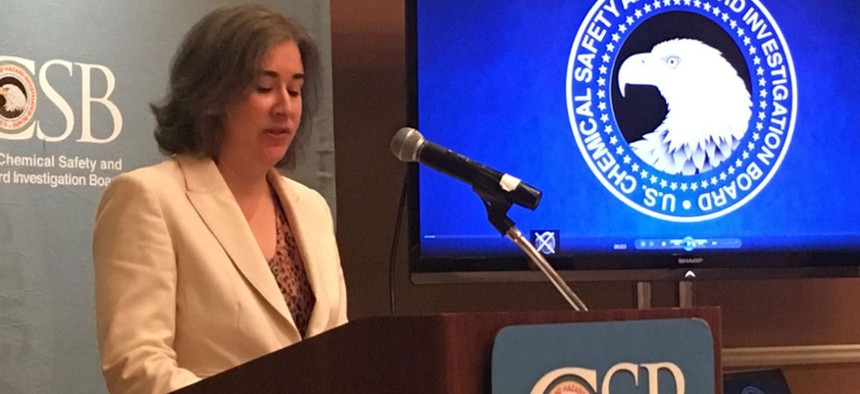Vacancy-Plagued Chemical Safety Board Gets Interim Chair
Citing family duties, Sutherland departs as staff of 40 shrinks to 32.
Vanessa Allen Sutherland left her post as chair of the independent Chemical Safety Board on Friday, having expressed confidence that her interim successor will continue the progress she sees in streamlining the small agency’s industrial accident probes and boosting sagging employee morale.
The Obama appointee who resigned after serving only three of her designated five years told reporters she was pleased with “significant organizational and investigatory improvements and the elimination of an investigation backlog.”
She appeared alongside board member Kristen Kulinowski, whom the board on June 12 voted to be “interim executive authority,” pending a permanent nominee to be named by President Trump. Kulinowski is a chemist and has served on the board since 2015.
The interim leader said that her talks with stakeholders such as people in industry show that “they want us to continue Vanessa’s work, as in providing solid documentation on reports, and fighting for continuing appropriations.”
The fact that Congress re-funded the $11 million, 40-person agency after Trump’s budget planner twice proposed its elimination “does help,” the interim chair said, “because congressional staff see that we’re taking less time for investigations and have increased our output—trends that hopefully will continue” even if the Trump team’s skepticism doesn’t let up.
She cited three strategic goals of preventing the recurrence of accidents, advocating for safety, and creating and maintaining an engaged workforce. She also plans to release a human capital strategy in July. “The number of investigators is my top priority,” as is getting “the staff up at least to where we were,” Kulinowski said.
Since Sutherland was brought in in August 2015 to an agency plagued by leadership scandals that brought congressional hearings, she has coped with recent unionization, some unhappiness with reclassification of attorneys and investigators, and some recent departures that have shrunk the staff to 32.
Even with her departure, there are two vacancies on the five-member board, no general counsel, and a departed human resources manager (since replaced). Managing Director Daniel Horowitz remains on administrative leave after nearly three years since a personnel action was proposed following a misconduct investigation, his attorney confirmed to Government Executive.
The iffy budget proposals “were a real challenge, both the budget amount and whether it would be granted at all,” Sutherland said. The uncertainty made it “difficult to hire or retain, make long-term expenditures, and conduct strategic, big-picture innovation and planning.” After much work revising job descriptions and classifications, the agency was able to bring in two Senior Executive Service members from the National Transportation Safety Board, along with a board affairs staffer, an executive director, a senior adviser and a records management specialist.
As specific accomplishments, Sutherland mentioned the agency’s updated investigative protocols, new factual updates on accident investigations and posted safety recommendations, as well as translations into Spanish for videos of interest to industry subcontractors who are not native-English speakers.
She came in with an intention to “be humble” and not pretend to know all the answers. But addressing governance issues and restoring intra-board communication were central, she said, particularly face-to-face rather than through multiple iterations of email. “Without clear roles and responsibilities,” it’s hard to focus on the mission,” Sutherland added.
Having come from a previous “fix-it” agency assignment (as chief counsel for the Pipeline and Hazardous Materials Safety Administration), she compared turning an agency around to “a massive rehab on your home—you get it livable,” but it remains a work in progress. Her ultimate goal, she said, was to “build an infrastructure that outlasts me and is not about me.”
She rebutted criticisms heard from some staff that leadership had pressured employees to hype the agency’s improvements to show progress on the Federal Employee Viewpoint Survey. She said the staff were reminded and “asked for a 100 percent response rate, not 100 percent giving us an A-Plus rating.”
Sutherland did not discuss her next move, but she suggested her departure had something to do with family obligations.




